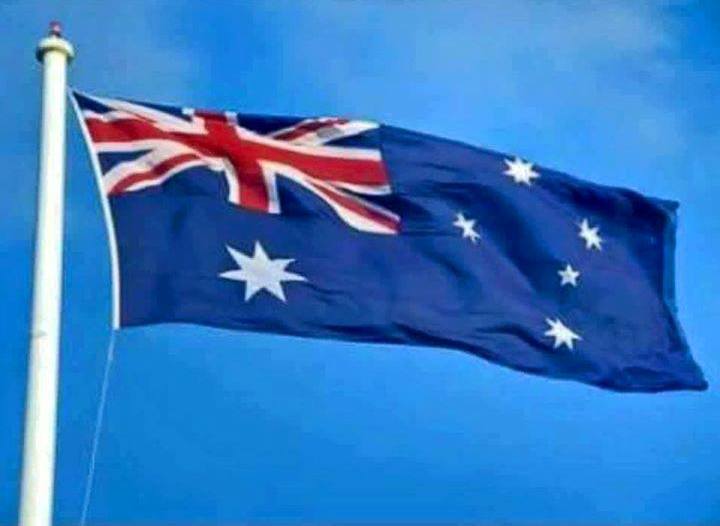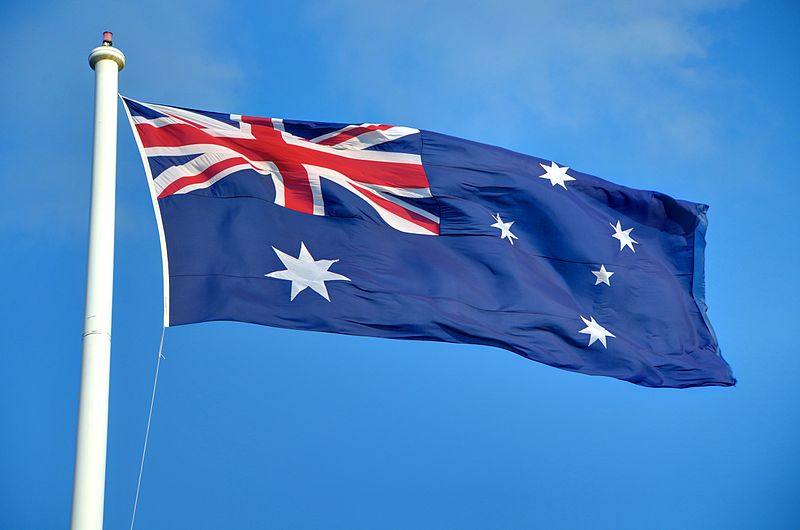Flag of Australia

Proportion 1:2 Adopted 11 February 1903 in use from 3 September 1901 8th December 1908 current seven-pointed Commonwealth Star version) Design.
A Blue Ensign defaced with the Commonwealth Star (also known as the Federation Star) in the lower hoist quarter and the five stars of the Southern Cross in the fly half.
The flag of Australia is based on the British maritime Blue Ensign – a blue field with the Union Jack in the canton or upper hoist quarter – augmented or defaced with a large white seven-pointed star (the Commonwealth Star) and a representation of the Southern Cross constellation, made up of five white stars – one small five-pointed star and four, larger, seven-pointed stars. There are other official flags representing Australia, its people and core functions of government. The flag’s original design (with a six-pointed Commonwealth Star) was chosen in 1901 from entries in a competition held following Federation, and was first flown in Melbourne on 3 September 1901, the date proclaimed as Australian National Flag Day. A slightly different design was approved by King Edward VII in 1903. The seven-pointed commonwealth star version was introduced by a proclamation dated 8 December 1908. The dimensions were formally gazetted in 1934, and in 1954 the flag became recognised by, and legally defined in, the Flags Act 1953, as the “Australian National Flag”.
The Australian flag uses three prominent symbols: the Union Flag, the Commonwealth Star (also the Federation Star) and the Southern Cross (or Crux). In its original usage as the flag of United Kingdom of Great Britain and Ireland, the Union Flag combined three heraldic crosses which represent the constituent countries of the United Kingdom (as constituted in 1801):
The red St George’s Cross of England
The white diagonal St Andrew’s Cross of Scotland
The red diagonal St Patrick’s Cross of Ireland
The Union Flag is thought to symbolise Australia’s history as six British colonies and the principles upon which the Australian Federation is based,although a more historic view sees its inclusion in the design as demonstrating loyalty to the British Empire.
The Commonwealth Star, also known as the Federation Star, originally had six points, representing the six federating colonies. In 1908, a seventh point was added to symbolise the Papua and any future territories.Another rationale for the change was to match the star used on the Coat of Arms, which was created in the same year. The Commonwealth Star does not have any official relation to Beta Centauri, despite the latter’s brightness and location in the sky; however, the 1870 version of the flag of South Australia featured the “pointer” stars, Alpha and Beta Centauri.
The Southern Cross is one of the most distinctive constellations visible in the Southern Hemisphere, and has been used to represent Australia since the early days of British settlement. Ivor Evans, one of the flag’s designers, intended the Southern Cross to also refer to the four moral virtues ascribed to the four main stars by Dante: justice, prudence, temperance and fortitude. The number of points on the stars of the Southern Cross on the modern Australian flag differs from the original competition-winning design, in which they ranged between five and nine points each, representing their relative brightness in the night sky. The stars are named after the first five letters of the Greek alphabet, in decreasing order of brightness in the sky. In order to simplify manufacture, the British Admiralty standardised the four larger outer stars at seven points each, leaving the smaller, more central star with five points. This change was officially gazetted on 23 February 1903.[6] A complete specification for the official design was published in the Commonwealth Gazette in 1934.
Construction
Under the Flags Act, the Australian National Flag must meet the following specifications: the Union Flag occupying the upper quarter next the staff; a large seven-pointed white star (six representing the six states of Australia and one representing the territories) in the centre of the lower quarter next the staff and pointing direct to the centre of St George’s Cross in the Union Flag; five white stars (representing the Southern Cross) in the half of the flag further from the staff.
The location of the stars is as followsthe Union Flag occupying the upper quarter next the staff;
Commonwealth Star – 7-pointed star, centred in lower hoist.
Alpha Crucis – 7-pointed star, straight below centre fly 1⁄6 up from bottom edge.
Beta Crucis – 7-pointed star, 1⁄4 of the way left and 1⁄16 up from the centre fly.
Gamma Crucis – 7-pointed star, straight above centre fly 1⁄6 down from top edge.
Delta Crucis – 7-pointed star, 2⁄9 of the way right and 31⁄240 up from the centre fly.
Epsilon Crucis – 5-pointed star, 1⁄10 of the way right and 1⁄24 down from the centre fly.
The outer diameter of the Commonwealth Star is 3⁄10 of the flag’s width, while that of the stars in the Southern Cross is 1⁄7 of the flag’s width, except for Epsilon, for which the fraction is 1⁄12. Each star’s inner diameter is 4⁄9 of the outer diameter. The flag’s width is the measurement of the hoist edge of the flag (the distance from top to bottom)

a large seven-pointed white star (six representing the six states of Australia and one representing the territories) in the centre of the lower quarter next the staff and pointing direct to the centre of St George’s Cross in the Union Flag; five white stars (representing the Southern Cross) in the half of the flag further from the staff.

The location of the stars is as follows
Australian Colonial Flag.svg Australian Federation Flag.svg Eureka Flag.svg AntiTransportation League Flag.svg Murray River Flag (Combined).svg National Colonial Flag Australian Federation Flag Eureka Flag Anti-Transportation League Flag Murray River Flag
From Wikipedia, the free encyclopedia
